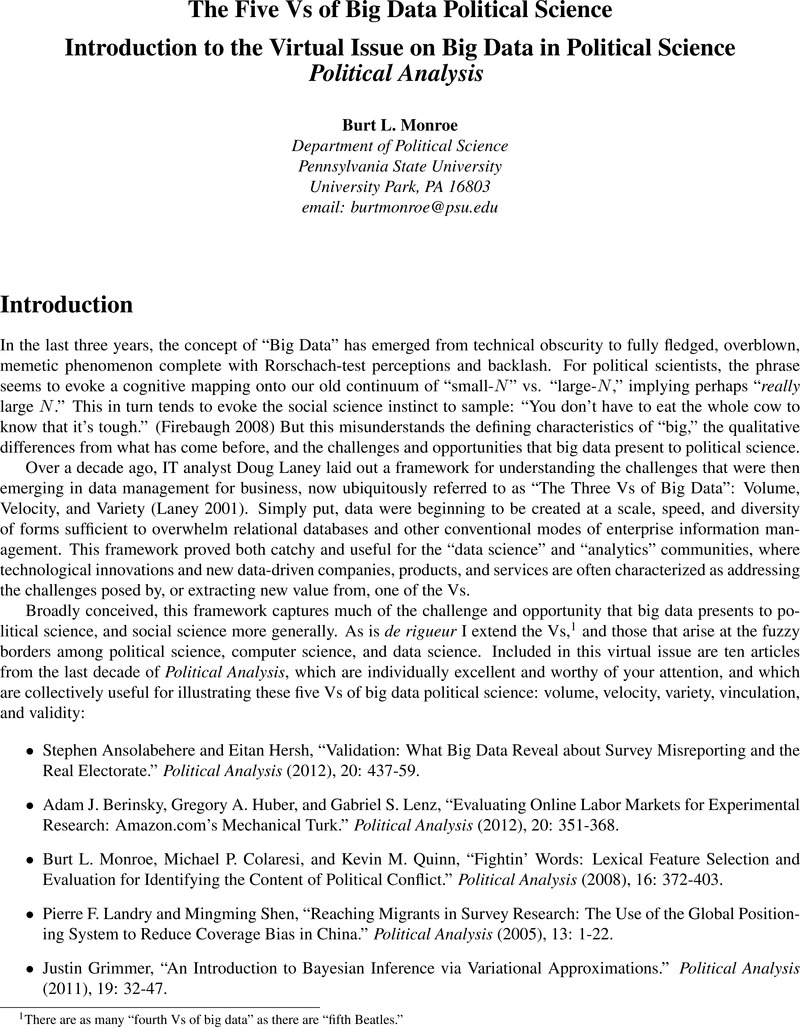Crossref Citations
This article has been cited by the following publications. This list is generated based on data provided by Crossref.
Fariss, Christopher J.
Jones, Zachary M.
Linder, Fridolin
Crabtree, Charles
Biek, Megan A
Ross, Ana-Sophia M
and
Tsai, Michael
2015.
Human Rights Texts: Converting Human Rights Primary Source Documents into Data.
SSRN Electronic Journal,
Mellon, Jonathan
2016.
Making Inferences About Elections and Public Opinion Using Incidentally Collected Data.
SSRN Electronic Journal ,
Aragona, Biagio
2016.
Big data o data that are getting bigger?.
SOCIOLOGIA E RICERCA SOCIALE,
p.
42.
Porter, Nathaniel D.
Verdery, Ashton
and
Gaddis, S. Michael
2017.
Enhancing Big Data in the Social Sciences with Crowdsourcing: Data Augmentation Practices, Techniques, and Opportunities.
SSRN Electronic Journal,
MacEachren, Alan M.
2017.
Spatial Data Handling in Big Data Era.
p.
139.
Gutmann, Myron P.
Merchant, Emily Klancher
and
Roberts, Evan
2018.
“Big Data” in Economic History.
The Journal of Economic History,
Vol. 78,
Issue. 1,
p.
268.
Munzert, Simon
and
Nyhuis, Dominic
2019.
Handbuch Methoden der Politikwissenschaft.
p.
1.
Nyhuis, Dominic
2020.
Fortgeschrittene Analyseverfahren in den Sozialwissenschaften.
p.
377.
Moreira, Davi
2020.
Com a Palavra os Nobres Deputados: Ênfase Temática dos Discursos dos Parlamentares Brasileiros.
Dados,
Vol. 63,
Issue. 1,
Mavriki, Paola
and
Karyda, Maria
2020.
E-Democracy – Safeguarding Democracy and Human Rights in the Digital Age.
Vol. 1111,
Issue. ,
p.
3.
Munzert, Simon
and
Nyhuis, Dominic
2020.
Handbuch Methoden der Politikwissenschaft.
p.
373.
Hultquist, Carolynne
Oravecz, Zita
and
Cervone, Guido
2021.
A Bayesian Approach to Estimate the Spatial Distribution of Crowdsourced Radiation Measurements around Fukushima.
ISPRS International Journal of Geo-Information,
Vol. 10,
Issue. 12,
p.
822.
Mahalle, Parikshit Narendra
Shinde, Gitanjali Rahul
Pise, Priya Dudhale
and
Deshmukh, Jyoti Yogesh
2022.
Foundations of Data Science for Engineering Problem Solving.
Vol. 94,
Issue. ,
p.
1.
Tyushka, Andriy
2022.
Weaponizing narrative: Russia contesting EUrope’s liberal identity, power and hegemony.
Journal of Contemporary European Studies,
Vol. 30,
Issue. 1,
p.
115.
Mitrani, Mor
Adams, Tracy
and
Noy, Inbar
2022.
Can We Algorithmize Politics? The Promise and Perils of Computerized Text Analysis in Political Research.
PS: Political Science & Politics,
Vol. 55,
Issue. 4,
p.
809.





